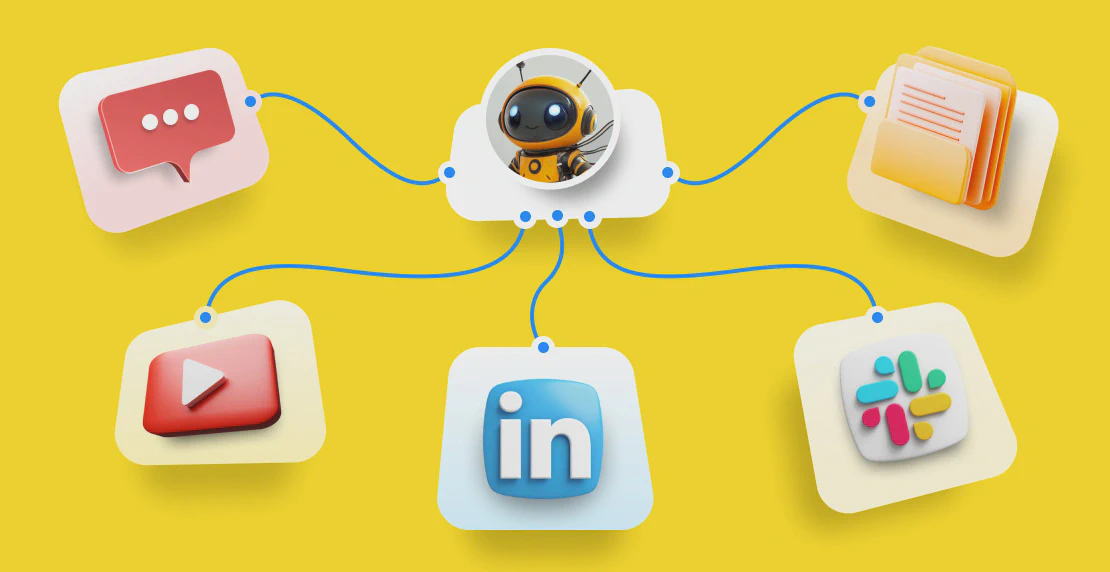What is no-code AI development
Remember the old days when making a website meant you had to learn all that HTML coding? Or how about when you wanted to build a simple database and …
Read article
It can be confusing to understand and keep up with the latest AI terms. So today, we will break down one of the most popular and important topics: AI agents.
Here is what we will cover in this article:
AI agents are software systems that use artificial intelligence to achieve goals on behalf of people and teams. Still not getting it? How about this… A brilliant digital colleague who, with your direction, will leverage the power of AI, connect with your current tools, and complete a range of tasks to achieve a goal for you!
You can have a plethora of agents in your AI toolbox and each individual agent can be a specialized expert in a particular field, assisting you in being your most productive self. They can handle tasks requiring research, analysis, decision-making, and implementation. The best part of AI agents is that they work alongside you and your team, adapting to your preferences while handling routine work so you can focus on the tasks you want to be doing.
It only takes a single objective to trigger an agent into research and development mode; you don’t need to keep checking in and providing new prompts; they can autonomously work away at completing a task independently. To become the experts they are, each agent operates by consuming a large amount of contextual information. Then, the agent will use its processors to understand the goal, use the information gathered to figure out the tools required to complete it, and then take action to achieve it.
For example, an agent designed to assist a Customer Support team will read all the previous support engagements to gain insight into the team’s voice and tone when speaking to customers, study the company documentation to form a complete, in-depth understanding of the product, and draft responses to any inbound customer questions.

You guessed it: send this agent the URL for your YouTube video, and the agent will transcribe the video, summarize it, and create a blog post.
Schedule a regular report to send directly to your MS Teams or Slack channels summarizing the trials your business has recently seen. See the source of trials, their behaviors on your site, and the likelihood of them converting to a paying customer.
Integrate with Hubspot to have an agent analyze the history of support tickets to find response patterns to common customer queries; also, upload your documentation so the agent understands the product and can draft responses to customer queries.
This is where the true time-saving power comes in. With recent advancements to large language models (LLM) like OpenAI’s GPT and Anthropic’s Claude, these models are now capable of reasoning, collating, and executing multi-step workflows, taking AI Agent outputs to the next level. You can combine all those individual experts together to execute a multi-step process in seconds. An entire day’s work, all ready for you in a few clicks.
For example, let’s take the Customer Support Agent example provided above. This agent has provided a draft response to a customer query, then this agent can send their output to another agent, which is integrated with the team’s Customer Relationship Management (CRM) tool, to draft the email response directly on the query thread. Another agent could then send a message to the Customer Support team channel in Slack, and request approval. Once approved, the message could be sent and documented in the correct areas.

Yes, AI agents can learn and adapt, just like a new colleague who takes a few days to excel at a task; agents are designed to grow and learn continually. The more you use the agent, the more it will help them refine their decision-making processes. As they are built with advanced machine learning techniques, they are able to learn and improve to be the best agent they can be for you. To improve the agent’s accuracy and performance, the human feedback loop is also crucial. More feedback will result in a better model - helping the AI model to understand the preferences of each individual user and team. A simple example of this is the thumbs up or thumbs down response to a ChatGPT output.

Even starting small with a single interaction with an agent can save you hours of time. Scheduling routine tasks like reports can free team members to complete more impactful work. We want Autohive in the hands of the teams in small and medium-sized businesses looking to grow and 10X the productivity of their teams. We know from experience how those teams continually look to make their work more efficient and effective.
AI agents now give these teams a cost-effective solution for growth. Because when it comes down to it, the ability to respond quicker to business needs or market changes will be the difference between you and your competitors. Look at how you can empower your team members to delegate the drudgery and pick up the exciting work they can bring to life. Particularly in a challenging market, agents can provide valuable insights and live trends to help with complete data-driven decision-making and make informed decisions that propel your business forward.
AI agents have been around for some time, but the accessibility of building these agents has always been limited due to the degree of technical expertise one must have to create and run them. Companies have always needed data scientists and machine learning engineers to build anything worthwhile. Autohive is passionate about bringing the power of AI agents to all teams across the globe, so we have built a no-code platform to remove all the hurdles in the way of every person finding, creating, and running their own AI agents. As no-code AI continues to evolve, we’re moving toward a future where your ideas matter more than technical skills.
Just imagine a world where you are sipping on your coffee, reading your board-worthy morning report from your data analysis agent, and sending approvals to agents across multiple channels to implement changes that would have taken you days to complete.
The first step is evaluating the tasks you currently own within your role. Think about the problems you want to solve and the drudgery you wish to remove from your everyday work, typically it will be repeated work that takes 1 hour or more to complete each time. Now, break down each task into a process you would follow to complete it. This process will help you to communicate to your agent clearly: The goal you want it to achieve The process you want it to follow to achieve it
Check out our blog post, “What is no-code AI development?” to learn how easy it is to build your own army of agents. Then, sign up to be the first to hear about Autohive hitting the market.
Remember the old days when making a website meant you had to learn all that HTML coding? Or how about when you wanted to build a simple database and …
Read articleIt’s Day 13, a bonus day of Autohive’s 12 Days of Christmas and we’ve saved a very special gift to finish with. Now, it’s time to check out the …
Read article